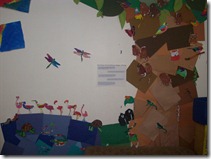Each year, my school puts on an International Day. Each of the elementary classrooms choose a country to study. The students and/or teacher (depending on the age group) gather information  about that country: the language, the religion, the food, the animals, the clothes, the flag, the plants etc. During the week leading up to International Day, the students visit the other classrooms to learn about the countries. Then, on International Day, parents come in for the big finale. Students get dressed up in traditional clothes of their country. There is food to taste from each country, and the students present what they have learned to their parents. After all of the presentations, the entire school gathers together for
about that country: the language, the religion, the food, the animals, the clothes, the flag, the plants etc. During the week leading up to International Day, the students visit the other classrooms to learn about the countries. Then, on International Day, parents come in for the big finale. Students get dressed up in traditional clothes of their country. There is food to taste from each country, and the students present what they have learned to their parents. After all of the presentations, the entire school gathers together for  songs, skits and dances from the different countries. Finally, we end it all by singing We are the World.
songs, skits and dances from the different countries. Finally, we end it all by singing We are the World.
This year, my class chose the Democratic Republic of Congo for International Day. One of my students is from this country, and her mom came in to help us out – she let the students interview her, as well as making the costumes and the food! My students learned about the rainforest, two animals that can’t be found anywhere else, a volcano eruption, and fufu – the national dish of the DRC. They painted the flag of Congo and made traditional Congolese masks in Art. They also learned a play  called Never Cry Croc – the Congolese version of the Boy Who Cried Wolf. It was a great learning experience for them!
called Never Cry Croc – the Congolese version of the Boy Who Cried Wolf. It was a great learning experience for them!
Does your school do anything to celebrate other countries?

![rrrbutton[4] rrrbutton[4]](https://lh3.ggpht.com/-vjGB50D6h3o/T4d4RGTfSmI/AAAAAAAABzk/_zjvG9XvJSM/rrrbutton%25255B4%25255D%25255B3%25255D.jpg?imgmax=800)






 about that country: the language, the religion, the food, the animals, the clothes, the flag, the plants etc. During the week leading up to International Day, the students visit the other classrooms to learn about the countries. Then, on International Day, parents come in for the big finale. Students get dressed up in traditional clothes of their country. There is food to taste from each country, and the students present what they have learned to their parents. After all of the presentations, the entire school gathers together for
about that country: the language, the religion, the food, the animals, the clothes, the flag, the plants etc. During the week leading up to International Day, the students visit the other classrooms to learn about the countries. Then, on International Day, parents come in for the big finale. Students get dressed up in traditional clothes of their country. There is food to taste from each country, and the students present what they have learned to their parents. After all of the presentations, the entire school gathers together for  songs, skits and dances from the different countries. Finally, we end it all by singing We are the World.
songs, skits and dances from the different countries. Finally, we end it all by singing We are the World. called Never Cry Croc – the Congolese version of the Boy Who Cried Wolf. It was a great learning experience for them!
called Never Cry Croc – the Congolese version of the Boy Who Cried Wolf. It was a great learning experience for them!
![rrrbutton[4] rrrbutton[4]](https://lh3.ggpht.com/-vjGB50D6h3o/T4d4RGTfSmI/AAAAAAAABzk/_zjvG9XvJSM/rrrbutton%25255B4%25255D%25255B3%25255D.jpg?imgmax=800)










 Here’s a quick tip for organizing items your students use on a daily basis My classroom configuration is set up so that my students are always sitting in groups. I like to keep one red bucket (shown in the picture) at each group.
Here’s a quick tip for organizing items your students use on a daily basis My classroom configuration is set up so that my students are always sitting in groups. I like to keep one red bucket (shown in the picture) at each group.
